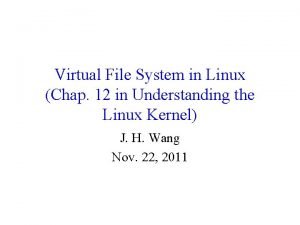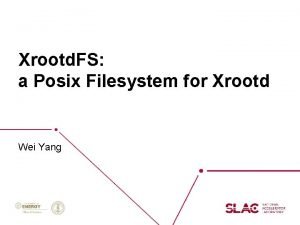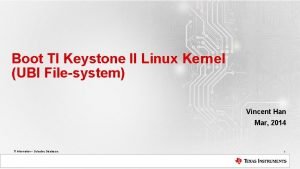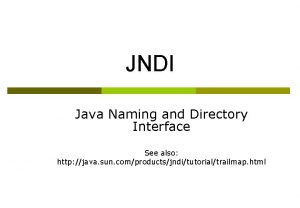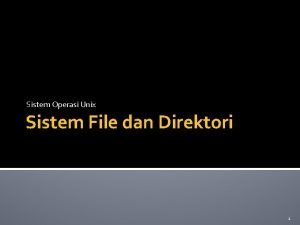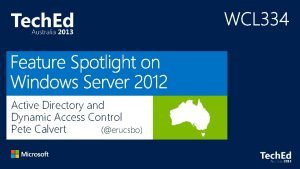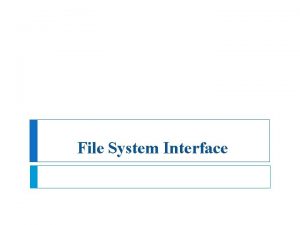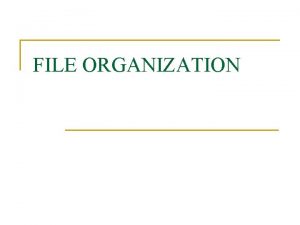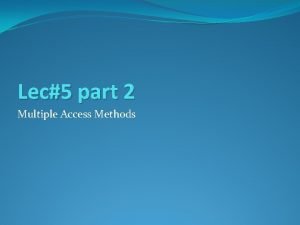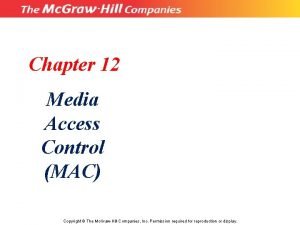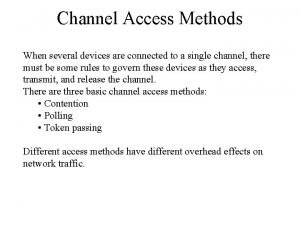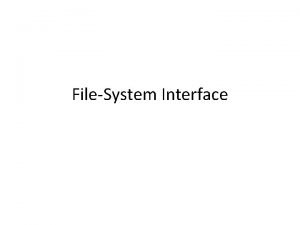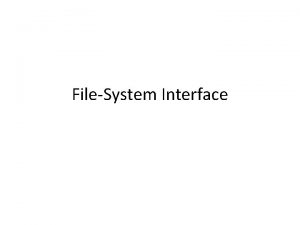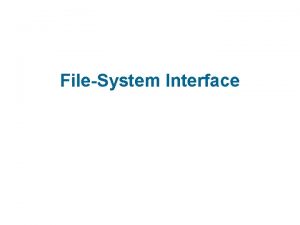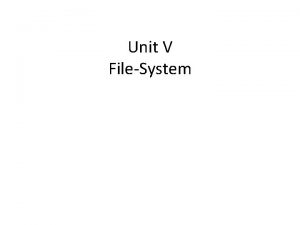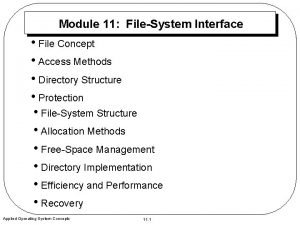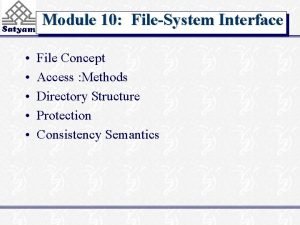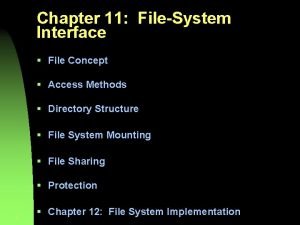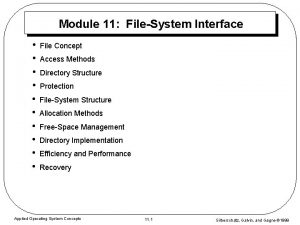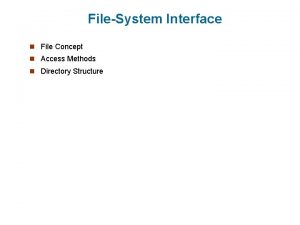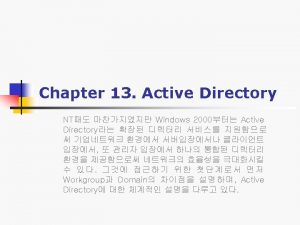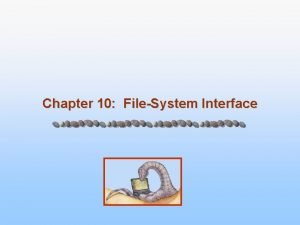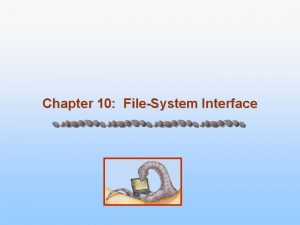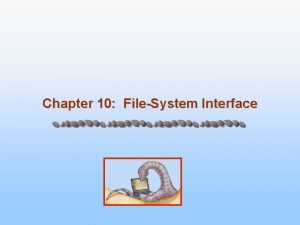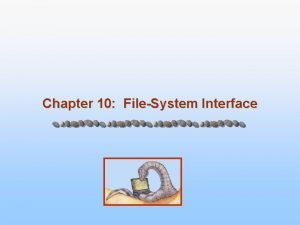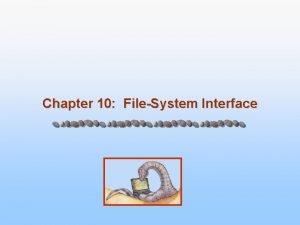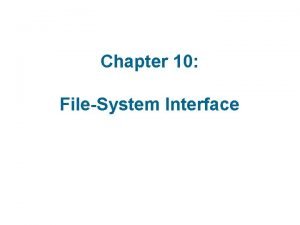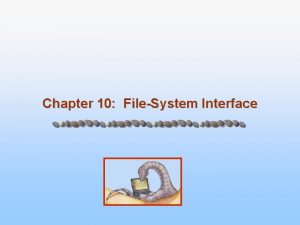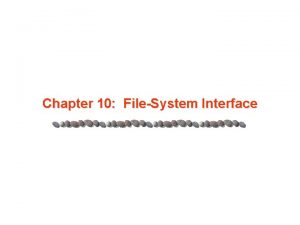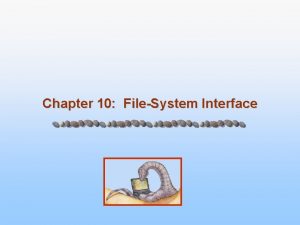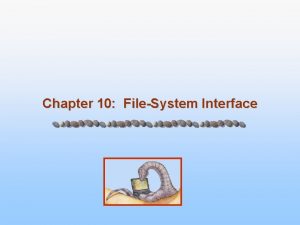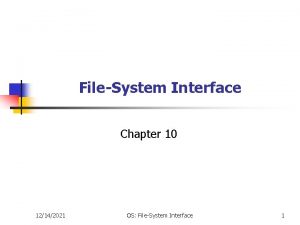FileSystem Interface 1 File Concept Access Methods Directory























- Slides: 23

File-System Interface • • • 1 File Concept Access : Methods Directory Structure Protection File System Structure SLC/VER 1. 0/OS CONCEPTS/OCT'99

File Concept • Contiguous logical address space • Types: – Data • numeric • character • binary – Program 2 SLC/VER 1. 0/OS CONCEPTS/OCT'99

File Structure • None - sequence of words, bytes • Simple record structure – Lines – Fixed length – Variable length • Complex Structures – Formatted document – Relocatable load file 3 SLC/VER 1. 0/OS CONCEPTS/OCT'99

File Structure • Can simulate last two with first method by inserting appropriate control characters. • Who decides: – Operating system – Program 4 SLC/VER 1. 0/OS CONCEPTS/OCT'99

File Attributes • Name – only information kept in humanreadable form. • Type – needed for systems that support different types. • Location – pointer to file location on device. • Size – current file size. • Protection – controls who can do reading, writing, executing. 5 SLC/VER 1. 0/OS CONCEPTS/OCT'99

File Attributes • Time, date, and user identification – data for protection, security, and usage monitoring. • Information about files are kept in the directory structure, which is maintained on the disk. 6 SLC/VER 1. 0/OS CONCEPTS/OCT'99

File Operations • • 7 create write read reposition within file – file seek delete truncate open(Fi) – search the directory structure on disk for entry Fi, and move the content of entry to memory. SLC/VER 1. 0/OS CONCEPTS/OCT'99

File Operations • close (Fi) – move the content of entry Fi in memory to directory structure on disk. 8 SLC/VER 1. 0/OS CONCEPTS/OCT'99

File Types – name, extension 9 SLC/VER 1. 0/OS CONCEPTS/OCT'99

Access Methods • Sequential Access read next write next reset no read after last write (rewrite) 10 SLC/VER 1. 0/OS CONCEPTS/OCT'99

Access Methods • Direct Access read n write n position to n read next write next rewrite n n = relative block number 11 SLC/VER 1. 0/OS CONCEPTS/OCT'99

Directory Structure • A collection of nodes containing information about all files. Directory Files F 1 F 2 F 3 F 4 Fn Both the directory structure and the files reside on disk. Backups of these two structures are kept on tapes. 12 SLC/VER 1. 0/OS CONCEPTS/OCT'99

Information in a Device Directory • • • 13 Name Type Address Current length Maximum length Date last accessed (for archival) Date last updated (for dump) Owner ID (who pays) Protection information (discuss later) SLC/VER 1. 0/OS CONCEPTS/OCT'99

Operations Performed on Directory • • • 14 Search for a file Create a file Delete a file List a directory Rename a file Traverse the file system SLC/VER 1. 0/OS CONCEPTS/OCT'99

Organize the Directory (Logically) to Obtain • Efficiency – locating a file quickly. • Naming – convenient to users. – Two users can have same name for different files. – The same file can have several different names. • Grouping – logical grouping of files by properties, (e. g. , all Pascal programs, all games, …) 15 SLC/VER 1. 0/OS CONCEPTS/OCT'99

Single-Level Directory • A single directory for all users. Naming problem Grouping problem 16 SLC/VER 1. 0/OS CONCEPTS/OCT'99

Two-Level Directory • Separate directory for each user. Path name Can have the same file name for different user Efficient searching No grouping capability 17 SLC/VER 1. 0/OS CONCEPTS/OCT'99

Tree-Structured Directories 18 SLC/VER 1. 0/OS CONCEPTS/OCT'99

Tree-Structured Directories • Efficient searching • Grouping Capability • Current directory (working directory) – cd /spell/mail/prog – type list 19 SLC/VER 1. 0/OS CONCEPTS/OCT'99

Tree-Structured Directories • Absolute or relative path name • Creating a new file is done in current directory. • Delete a file rm <file-name> mail prog 20 copy prt exp count Deleting “mail” deleting the entire subtree rooted by “mail”. SLC/VER 1. 0/OS CONCEPTS/OCT'99

Tree-Structured Directories • Creating a new subdirectory is done in current directory. mkdir <dir-name> Example: if in current directory /spell/mail mkdir count 21 SLC/VER 1. 0/OS CONCEPTS/OCT'99

Protection • File owner/creator should be able to control: – what can be done – by whom • Types of access – Read – Write – Execute – Append – Delete and List 22 SLC/VER 1. 0/OS CONCEPTS/OCT'99

File System Structure • File Structure -Logical storage unit -Collection of related information • File system resides on secondary storage (disks) • File system organized into layers. • File control block- storage structure consisting of information about a file 23 SLC/VER 1. 0/OS CONCEPTS/OCT'99
 Pathname lookup in linux's virtual filesystem
Pathname lookup in linux's virtual filesystem Posix filesystem
Posix filesystem Ubi filesystem
Ubi filesystem File-file yang dibuat oleh user pada jenis file di linux
File-file yang dibuat oleh user pada jenis file di linux Distributed file system
Distributed file system Jndi name
Jndi name Manajemen file pada unix
Manajemen file pada unix Active directory dynamic access control
Active directory dynamic access control Interface in interface java
Interface in interface java Office interface vs industrial interface
Office interface vs industrial interface Office interface vs industrial interface
Office interface vs industrial interface Interface------------ an interface *
Interface------------ an interface * File system interface
File system interface Direct and indirect wax pattern
Direct and indirect wax pattern Indexed sequential file organization
Indexed sequential file organization Difference between logical file and physical file
Difference between logical file and physical file Fungsi dari create file pada operasi-operasi file (cont.)
Fungsi dari create file pada operasi-operasi file (cont.) An html file is a text file containing small markup tags.
An html file is a text file containing small markup tags. In a file-oriented information system, a transaction file
In a file-oriented information system, a transaction file Controlled access methods
Controlled access methods Media access control methods
Media access control methods Channel access method
Channel access method Terminal access controller access control system
Terminal access controller access control system Terminal access controller access-control system
Terminal access controller access-control system
